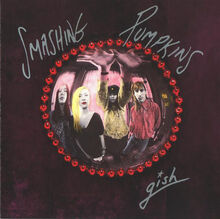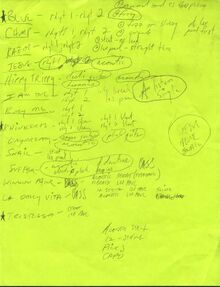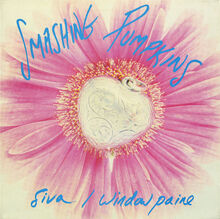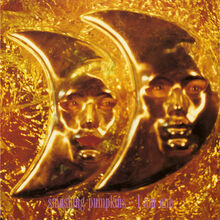Dec 1990-Mar 1991 - Smart Studios, Madison, WI
Produced by Butch Vig and Billy Corgan
- Blue
- Bury Me
- Crush
- Daydream
- I Am One
- I'm Going Crazy
- Jesus Loves His Babies
- Pulseczar
- Rhinoceros
- Siva
- Slunk
- Snail
- Suffer
- Tristessa
- Why Am I So Tired
- Window Paine
- Chump (Slunk with Jimmy vocals)
- La Dolly Vita
- Razor

Proper recording sessions for Gish. A number of songs were recorded aside from the ten album tracks and the eleventh hidden track (which was recorded live in the monitor room): "Slunk", "Blue" and "Jesus Loves His Babies" were outtakes intended for b-sides in 1991, although the later never appeared on a release; "Chump" is an alternate mix of "Slunk" which featured Jimmy on vocals, found on the Mashed Potatoes unofficial box set; "Pulseczar" dates from these sessions, meant as a demo but appearing on Earphoria; likewise on Earphoria, "Why Am I So Tired" is noted as a live in-studio demo, thus it's probably that James and D'Arcy's parts are in tact (James is probably the guitar panned left); a new version of "La Dolly Vita" was attempted but abandoned.
Recording Gish was done in spurts. "We would drive up to Madison for four days at a time — or six days at a time. We had no money, so Jimmy and I were staying with some really nice college girls who let us stay in their house for free. That gave us a little more money for the record. The studio was $500 a day, and that was with Butch included. If my memory serves me correctly, it took us 41 days to record the album and seventeen days to mix."[1]
“Billy was very ambitious,” Vig remembers. “He wanted to make everything sound amazing and see how far he could take it; really spend time on the production and the performances. For me that was a godsend because I was used to doing records for all the indie labels and we only had budgets for three or four days.”

The band loaded into the studio with a modest amount of gear, most of which can be seen in their first few videos. On stage, the band’s signature sound was rooted in Corgan and Iha’s mid-’70s Strat/’87 Les Paul combination, but the recording centered around Corgan’s rig: An early ’80s Marshall JCM 800 2203, known as the “Soul Head,” run through Marshall 1960A cabinets, all purchased off “some stoner guy” in Chicago for $800. The KT88 tubes in the JCM produce a round, creamy tone that, when used in conjunction with an ADA MP-1 tube preamp, produced the Gish tone. Using the low input side of the JCM, Corgan would turn the master volume all the way up, and then use the preamp’s volume to make micro adjustments. A host of effects, from the Fender Blender to the Phase 100, were folded in for extra fuzz and sweep comb filtering. The bass parts were recorded with Wretzky’s black Fender P-Bass—dubbed the “Rat Bass” for the scattering of white rat stickers all over the face—and played through a Trace Elliot AH300SM.

“Billy was ‘green’ only in the sense that he didn’t necessarily have handson experience, but he knew what he wanted,” Vig continues. “He’s a big fan of Queen and ELO, and those records had big produced sounds, and as much as he didn’t know maybe from an engineering standpoint how to do it, I think sonically what he heard in his head, he understood.”
The band would collectively hash out the arrangements through exhaustive rehearsals, but when it came time to record, Corgan laid down the majority of the parts. This oft-talked about procedure became a standard practice.
“As good as D’arcy and James are, it was just going to sound better if Billy played it,” says Vig. “I think it probably caused some friction, but it was something they dealt with and accepted in the band.”
The drums were the one component of the Smashing Pumpkins that Corgan could not reproduce. A jazz drummer by trade, Jimmy Chamberlin paired swing and subtlety with a thunderous intensity reminiscent of legends like Keith Moon and John Bonham. Chamberlin has been a Yamaha endorsee since 1993, but back then his setup was a Pearl DLX Series kit with a 16x22-inch kick and a Yamaha steel snare. As Chamberlin remembers, the kit was miked with Sennheiser 421s on the toms, Shure SM57s on the snare, an AKG D112/Electro-Voice RE20 combo on the kick, and AKG C414s as overheads.
At the time, Vig didn’t have a tremendous amount of money to make significant cosmetic changes to Smart, but the shape of the studio’s live room—all odd angles and no parallel walls—made for an incredible sound, inspiring the live feel of the band’s studio performance. Gish was recorded onto a two-inch, 24-track Otari MX80, but few things were recorded through the studio’s newly acquired 56-input customized Harrison console (Vig relied largely on outboard Summit and API preamps) though he says that Harrison’s versatile EQ section and exceptional high- and low-pass filters made it easier to quickly carve out pockets in the mix for Corgan’s unique tone. When all was said and done, Gish cost around $20,000 to produce, and took just over 30 days to record.
“For me that was the equivalent of making a Steely Dan record,” laughs Vig who, two months after wrapping production on Gish, traveled to Los Angeles to record Nirvana’s Nevermind. “Having that luxury to spend hours on a guitar tone or tuning the drums or working on harmonies and textural things . . . I was over the moon to think I had found a comradein- arms who wanted to push me, and who really wanted me to push him.”[2]
Billy Corgan: Butch Vig loves vocals, so when I was sitting in Smart Studios, circa 1990, and I was cranking the guitar, he was looking at me like, "Yeah, every guitar player wants to crank the guitar." And I'm saying, "No, you don't understand. The guitars need to sit here for a reason." I wasn't turning up the guitars ‘cause I'm a guitar player, I was telling him, "This is the best way." Then I, of course, put what we call "Pumkinizer" around my vocals and then buried my vocal, like Exile on Main Street. He was looking at me like, "Wait a second." He pulled the faders down and said, "This is where the guitars should be, and this is where the vocals should be." I said, "That sounds boring." I put the faders back up, and I pulled the voice back up. "That's the sound. That's the sound." So I was saying that. And he was looking at me going, "Wait, you're the songwriter. You're the singer. You're the guitar player. Who am I talking to?" I was trying to say to him, "This is the producer talking." It's hard to have credibility in that moment, because they ultimately assume that you're like every other musician who wants to hear their part, their way.
Butch Vig: We'd go in the studio for 14 or 15 hours a day and just go to battle as co-producers. It wasn't like we were yelling at each other, but we were constantly trying to up the ante. I'd
say, "Well, you can probably do that better." Or he'd say, "I don't think that sounds right. You can get a better sound on this." So we were just constantly pushing each other. I loved that. I respected that.

Jimmy Chamberlin: "I Am One" was really begat out of a drum machine beat that Billy had come up with that was really almost impossible to play on a drum kit. It's just one of those things where somebody writes something on a drum machine with absolutely no idea of hand-and-foot proximity, and then says, "Hey, what do you think about this?" "Oh, it sounds great" "Well, can you play it?" "Well, I can come back in a week and play it, but in order to play it faithfully I've gotta do a single paradiddle on my floor tom, and then bring my left hand..." There's a pedagogical component to learning that. The genesis of moving my big [floor] tom over to the left was just trying to assimilate that beat.
Billy Corgan: If you go back and listen to "I Am One," and the drum balance on the toms, those are not geeked up; those are him hitting the drums. That's the concussiveness of the way he's playing coming through the room mics. Oftentimes when you hear drummers play, and then you see them live, they don't have the same power because they're aided by the studio balance. That is actually true to Jimmy's balance; what you hear is how Jimmy sounded in the room.[3]
Return to Gish